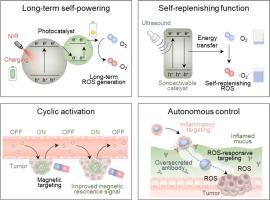可持续癌症治疗
IF 22
1区 材料科学
Q1 MATERIALS SCIENCE, MULTIDISCIPLINARY
引用次数: 0
摘要
近年来,通过激活分子或纳米颗粒来启动长期癌症治疗作用的可持续癌症治疗引起了越来越多的关注。大量的临床前和临床研究表明,持续的癌症治疗可以有效地引发肿瘤消退。目前,近红外光、x射线和超声刺激被广泛用于触发长期治疗效果。特别是x射线和超声,由于其出色的组织穿透能力,可以提高治疗效果,在深部肿瘤治疗中具有重要的潜力。值得注意的是,长期的光子和超声激活可以与各种疗法协同结合,如声动力疗法、光热疗法、光动力疗法和免疫疗法,进一步提高治疗效果。此外,化学动力疗法能够实现协同双重激活,包括循环和可切换反应,以引发持续的治疗效果。这篇综述概括了癌症可持续治疗的最新方法和益处,特别是对于难治性肿瘤,并强调了癌症持续治疗可以包含长期的自我供电、自主控制和自我补充功能。至关重要的是,刺激反应可持续癌症治疗的挑战和未来前景进行了审查,以促进其进步和临床应用。本文章由计算机程序翻译,如有差异,请以英文原文为准。

Sustainable cancer therapy
Sustainable cancer therapy, achieved through the activation of molecules or nanoparticles that initiate long-term cancer-therapeutic actions, has attracted increasing attention in recent years. Numerous pre-clinical and clinical investigations have shown that sustainable cancer treatments can effectively trigger tumor regression. Currently, near-infrared light, X-rays, and ultrasound stimuli are extensively employed to trigger long-term therapeutic effects. In particular, X-rays and ultrasound possess significant potential for deep tumor therapy due to their excellent tissue penetration capabilities, which can boost treatment efficacy. Notably, long-term photonic and ultrasound activation can be synergistically combined with various therapies, such as sonodynamic therapy, photothermal therapy, photodynamic therapy, and immunotherapy, to further enhance therapeutic efficacy. Additionally, chemodynamic therapy enables synergistic dual activation, including cyclic and switchable reactions, to elicit a sustained therapeutic effect. This review encapsulates recent methodologies and benefits of sustainable cancer treatment, particularly for intractable tumors, and underscores that sustained cancer treatment can incorporate long-term self-powering, autonomous control, and self-replenishing functions. Crucially, the challenges and future outlooks of stimuli-responsive sustainable cancer therapy are examined to foster its advancement and clinical applications.
求助全文
通过发布文献求助,成功后即可免费获取论文全文。
去求助
来源期刊

Materials Today
工程技术-材料科学:综合
CiteScore
36.30
自引率
1.20%
发文量
237
审稿时长
23 days
期刊介绍:
Materials Today is the leading journal in the Materials Today family, focusing on the latest and most impactful work in the materials science community. With a reputation for excellence in news and reviews, the journal has now expanded its coverage to include original research and aims to be at the forefront of the field.
We welcome comprehensive articles, short communications, and review articles from established leaders in the rapidly evolving fields of materials science and related disciplines. We strive to provide authors with rigorous peer review, fast publication, and maximum exposure for their work. While we only accept the most significant manuscripts, our speedy evaluation process ensures that there are no unnecessary publication delays.
 求助内容:
求助内容: 应助结果提醒方式:
应助结果提醒方式:


